|
 Guitar # 002 Guitar # 002
The original Cutting-board
Maple/Birch through-neck electric
Completed October 22, 2014... Started sometime in the year 2000.
Talk about finishing guitars out of order. Fourteen years for this
build. This guitar started as my late father-in-law's old cutting
board. I acquired the main chunk of wood for the body while rummaging
around in my mother-in-laws basement.
At that time it was a big piece of wood of unknown type. Lots of
stains, cut, and dings. "What's this?" I said to my wife
Diana. "It's my dads old cutting board. He butchered meat using
it." was her reply. I said, "He wont be needing this
anymore." You see, he had passed away a year before this.
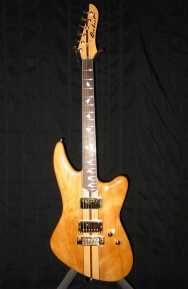  I gave it the rough eye ball inspection and guesstimated
it has enough wood
in it to carve past the cuts and make a guitar body. I took it home and
started carving. It turned out some small areas of the wood were almost skunky (soft almost
rotting), so sanding a smooth curved line was next to
impossible. The sandpaper always seemed to dig in over the soft
areas. This was my second guitar and I didn't really know
better. I gave it the rough eye ball inspection and guesstimated
it has enough wood
in it to carve past the cuts and make a guitar body. I took it home and
started carving. It turned out some small areas of the wood were almost skunky (soft almost
rotting), so sanding a smooth curved line was next to
impossible. The sandpaper always seemed to dig in over the soft
areas. This was my second guitar and I didn't really know
better.
At that point I still didn't have a good place to work. I cut the basic
shape with an old jig saw, did a bit of carving but left it until I finally
rented space. Mainly the wood sat for a few more years. But a few more years wouldn't
hurt it.
When I finally got to joining the neck and refining the shape (read, carving
away the cuts) my wife stopped me, saying, "you have to leave some cuts in
that guitar. If you take out all the cuts, how would anyone know it was my
dads? Besides, you can't ever sell that guitar because it was my dads
cutting board! That is MY guitar" 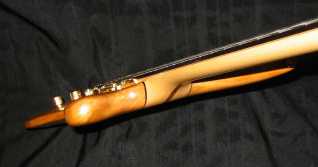
"Ok, But you don't play?!" I said.
"Don't care - It's My Guitar!" She said.
Ok - fine, Some cuts stay! I left some small meat cutting marks on the
back, and a few hacks in the front. At the time I got some used pickups
and to this day I have no idea what brand they are. Same for the
tuners. There was also no priority in completing it, since paying customers
guitars always get moved to the front of the line, and since there are also all
those more interesting woods.
This guitar's outline shape was inspired by my old Toledo, but
in this case, the top and
back are carved and the guitar is fairly thin. It is relatively light for
a solid body. The guitar is a Through-neck design where the neck continues
all the way through the body. The neck is a laminate with a quarter inch strip of Bocote down the middle,
and Hard Maple on each side. The body "wings" are glued to the
sides of the neck, with a one sixteenth inch strip of Ebony between the neck and
wings. It turned out the body made of the old cutting board
was in fact a chunk of Birch. The fret board is also made of Bocote with
Ebony and Maple binding. The Dickert logo is inlayed Bocote as well.
Gold mother of pearl random shape position marks to go with all the gold
hardware. The bridge is the gold Schaller 455 model which is one of
the better bridges available.
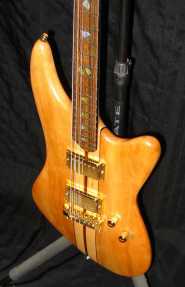 When
people ask what I was going to call this model of guitar? My reply was
easy to think of. It's called "The Cutting-board" When
people ask what I was going to call this model of guitar? My reply was
easy to think of. It's called "The Cutting-board"
Now that I've finally got a chance to plug it in, and
crank the amp up to 11, I was actually quite surprised by those old
no-name pickups. They actually growl. The guitar has a nice thick
warm bridge pickup sound and very bright bridge just the way you want it.
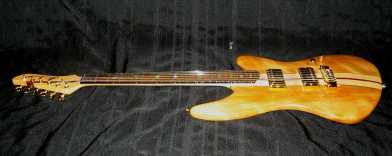 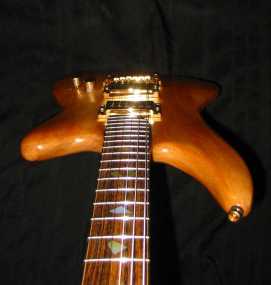

Back

|
![]()
![]()